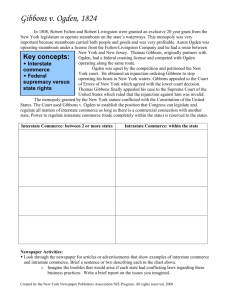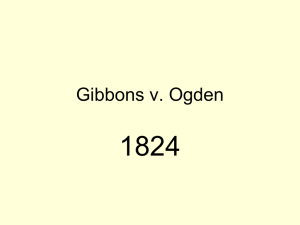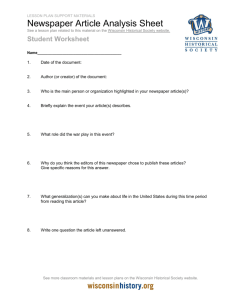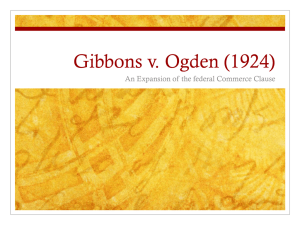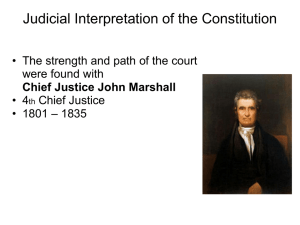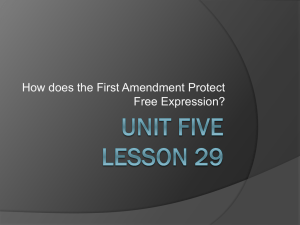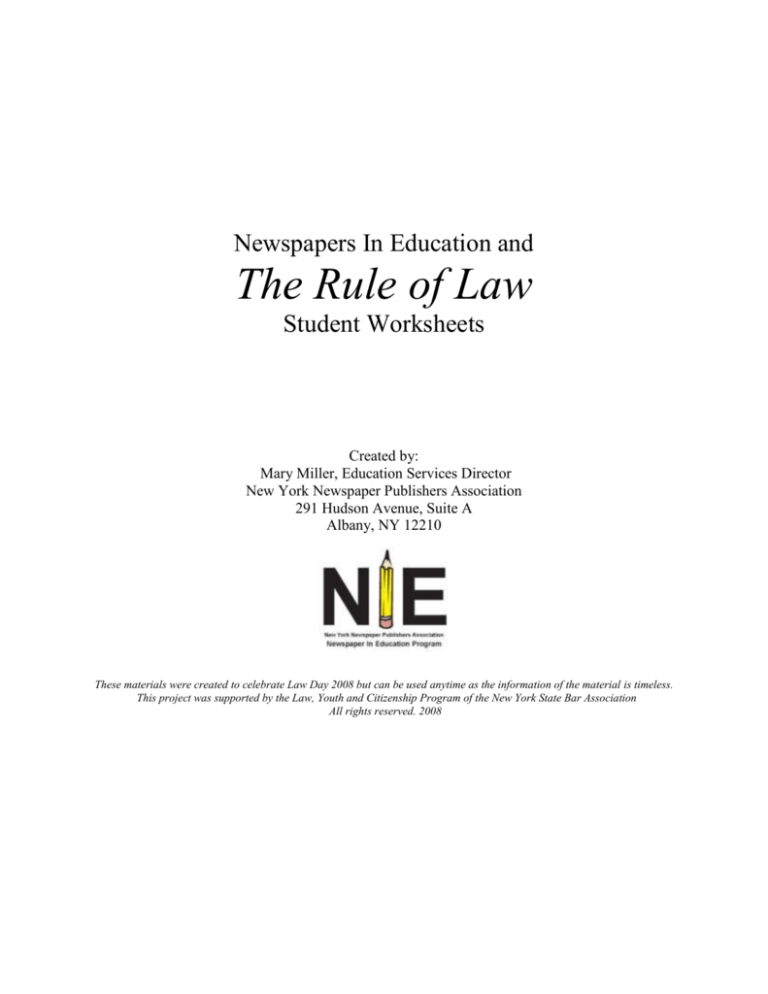
Newspapers In Education and
The Rule of Law
Student Worksheets
Created by:
Mary Miller, Education Services Director
New York Newspaper Publishers Association
291 Hudson Avenue, Suite A
Albany, NY 12210
These materials were created to celebrate Law Day 2008 but can be used anytime as the information of the material is timeless.
This project was supported by the Law, Youth and Citizenship Program of the New York State Bar Association
All rights reserved. 2008
Introduction
According to the U.S. Department of State, “In a democracy, the rule of law is manifested in an
independent judiciary, a free press and a system of checks and balances on leaders through free elections
and separation of powers among the branches of government....the rule of law is based primarily on the
U.S. Constitution and on the assurance that U.S. laws are fair and are applied equally to all members of
society.”
Indeed, newspapers and other media not only act as government “watchdogs” but constantly
reflect the “living constitution” in its coverage. Whether by formal Constitutional amendment or by
legislation passed by Congress, executive agreements, and court decisions, our legal system is both
consistent and ever changing.
We hope this series educates you to New York’s role in our legal history. This series is intended
to prompt discussion in the classroom and give a deeper understanding of the law, especially the U.S.
Constitution.
This guide that will focus on key court cases throughout New York State history. These
cases, among others, helped establish the rule of law.
The features will highlight the following cases:
The Crown v. John Peter Zenger
Gibbons v. Ogden
Lochner v. New York
Engel v. Vitale
New York Times v. United States
All but the first are cases that went up to the Supreme Court.
The Crown v. John Peter Zenger, 1735
In the early 1730s, John Peter Zenger, a German immigrant, started publishing The New-York
Weekly Journal. In it, he printed articles by opponents of Governor William Cosby criticizing his
removal of the colony’s Chief Justice from office. These articles mocked Cosby while warning against
leaders who put themselves above the law. Outraged, Governor Cosby ordered copies of select issues
seized and burnt and Zenger was eventually indicted for seditious* libel.
After months in jail, Zenger’s trial began, but his lawyers were disbarred
Key concepts:
and prevented from defending their client. Andrew Hamilton, a
Independent
Philadelphia lawyer, took over the case and offered a defense that went
against traditional English law.
juries
In England, proof of publication was all that was necessary to
Freedom of the
convict a publisher of libel. Whether the alleged libel was true or not
Press
didn’t matter. Hamilton insisted that the truth should make a difference:
if Zenger had published the truth, he couldn’t be guilty of libel.
When the court rejected Hamilton’s argument, the lawyer urged jurors to decide for themselves.
They acquitted Zenger, setting a precedent in favor of truth that was later affirmed by courts in England
and the United States. Thus, a jury of regular men helped lay the foundation for one of the freedoms in
the First Amendment of the U.S. Constitution.
____________________________________________________________
*Sedition: word or action inciting rebellion against the authority of a state.
Newspaper Activity:
Locate articles, editorials or political cartoons that report on the decisions of local, state or national
government leaders. As a class, discuss how this information would be different without the protection
of Freedom of the Press. Rewrite or redraw this coverage as it might be reported without the First
Amendment. Organize your thoughts in the chart below.
Summary of examples found in the newspaper
Examples of differences without 1st Amendment
Gibbons v. Ogden, 1824
In 1808, Robert Fulton and Robert Livingston were granted an exclusive 20 year grant from the
New York legislature to operate steamboats on the state’s waterways. This monopoly was very
important because steamboats carried both people and goods and was very profitable. Aaron Ogden was
operating steamboats under a license from the Fulton-Livingston Company and he had a route between
New York and New Jersey. Thomas Gibbons, originally partners with
Key concepts: Ogden, had a federal coasting license and competed with Ogden
operating along the same route.
Interstate
Ogden was upset by the competition and petitioned the New
commerce
York court. He obtained an injunction ordering Gibbons to stop
Federal
operating his boats in New York waters. Gibbons appealed to the Court
supremacy versus
of Errors of New York which agreed with the lower court decision.
state rights
Thomas Gibbons finally appealed his case to the Supreme Court of the
United States which ruled that the injunction against him was invalid.
The monopoly granted by the New York statute conflicted with the Constitution of the United
States. The Court used Gibbons v. Ogden to establish the position that Congress can legislate and
regulate all matters of interstate commerce as long as there is a commercial connection with another
state. Power to regulate intrastate commerce (trade completely within the state) is reserved to the states.
Interstate Commerce: between 2 or more states
Intrastate Commerce: within the state
Newspaper Activities:
Look through the newspaper for articles or advertisements that show examples of interstate commerce
and intrastate commerce. Brief a sentence or two describing each in the chart above.
o Imagine the troubles that would arise if each state had conflicting laws regarding these
business practices. Write a brief report on the issues you imagined.
L ochner v. New York, 1905
In the 1890s, New York enacted the Bakeshop Act which set
Key concepts: minimum standards for sanitation and a maximum ten-hour work day and
sixty-hour week for bakeshop employees. This was one of many laws
Due process
passed during the turn of the century that regulated hours, wages, and
“Freedom of
conditions of work with the intent of protecting the public health and
contract”
welfare of the individual.
State “police
In 1902, Joseph Lochner, a tiny bakery owner in Utica, was
powers”
convicted and fined $50 for permitting an employee to work more than the
lawful number of hours. Lochner appealed his conviction up to the New
York Court of Appeals which affirmed his sentence. Claiming the law was unconstitutional under the
Fourteenth Amendment, depriving him of life, liberty, or property without due process of law, Lochner
appealed to the U.S. Supreme Court.
In a controversial decision, the Court held that, “…There is no reasonable ground for interfering
with the liberty of person or the right of free contract, by determining the hours of labor, in the
occupation of a baker...”* The New York law in question was not within the limits of its “police
powers.” This ruling marked the beginning of a “substantive due process” era in the Court which it used
to balance freedoms of the individual and the power of government. Eventually Lochner was overturned
by another case 12 years later.
______________________________________________
*Excerpt from the majority decision by Justice Peckham.
Newspaper Activity:
Look through the newspaper for articles about something the government has done or proposes to do
that will work for the greater good of the entire community. Use the Venn diagram below to compare
and contrast one of these to your understanding of the Bakeshop Act.
Engel v. Vitale, 1962
In 1951 the New York State Board of Regents in an attempt to build character and instill good
citizenship in students developed and approved a “nondenominational
prayer.” It read, “Almighty God, we acknowledge our dependence
Key concepts:
upon Thee, and we beg Thy blessings upon us, our parents, our
Establishment
teachers and our Country.” All school districts were encouraged to
clause
have students recite it at the start of each school day. Participation was
Governmentnot mandatory.
The parents of public school pupils in New Hyde Park schools
directed prayer in
objected that the prayer contradicted their religious beliefs. They filed
public schools
suit in a New York State court seeking a ban on the prayer. The
appeals court upheld the use of the prayer, “so long as the schools did
not compel any pupil to join in the prayer over his or his parents’ objection.” And in 1961, citing the
prayer as a violation of the Establishment Clause in the First Amendment, the parents brought their case
to the Supreme Court.
The court decided that government-directed prayer in schools was unconstitutional and a
violation of the Establishment Clause. This was the first of several cases in which the Court used the
Establishment Clause limiting government-directed prayer. More than 45 years have passed since this
decision and it remains extremely controversial.
Newspaper Activity:
Look through editions of the newspaper for editorials. Note how these persuasive pieces use facts to
support their opinion. Use these editorials as a model and write whether you agree with the Engel v.
Vitale decision or disagree with it and why. Use the grid below, organize the facts you’ve found
concerning prayer in schools. Be sure to include the points that support the opposing point of view. By
knowing and understanding the opposition’s argument, you can strengthen your own position.
SUPPORTING FACTS
PROS
CONS
Extension activity: Have the class share its opinions verbally during a controlled debate.
Better at expressing yourself visually? On the back of this sheet draw an editorial cartoon that clearly
argues your side of the issue.
New York Times v. United States, 1971
In 1967 Secretary of Defense McNamara commissioned a study of the history of US decisionmaking of policies involving Indochina, specifically Vietnam. The resulting documents became known
as the Pentagon Papers. In 1971, Daniel Ellsberg, a government researcher, gave copies of the
documents to the press.
On June 13, 1971, the New York Times began publishing articles about the documents and the
Washington Post published information later that same week. On June 15 the government went to a New
York federal district court seeking an injunction prohibiting the Times from publishing articles about the
Pentagon Papers. The government pursued similar action against the Post in the District of Columbia.
Both federal district courts refused to issue a permanent injunction.
The Supreme Court heard arguments on June 26. The government
Key concepts: argued that prior restraint (prohibiting information from being published)
was necessary to protect national security. However, on June 30, a
Executive power
divided Court refused to stop publication of the Pentagon Papers because
Freedom of the
the government failed to meet the burden to justify prior restraint. This
Press
case became an important precedent in support of the First Amendment’s
freedom of the press.
Newspaper Activity:
Our nation’s founders realized someone needed to hold the government accountable for its actions. The
First Amendment, freedom of the press, ensures that newspapers and other media continue to serve as
the “public’s watchdog.” Publishing information and commentary on controversial topics are two ways
newspapers exercise this responsibility.
Look through editions of the newspaper for examples of the newspaper holding the government or
elected officials responsible for their actions (or in some cases, inaction). Imagine you are an elected
official; briefly write how you would work to resolve this issue.
Issue
Your solution
If you’ve enjoyed this guide and would like to learn more about civics and law related education visit
the Law, Youth and Citizenship Program of the NYS Bar Association online at www.lycny.org.

